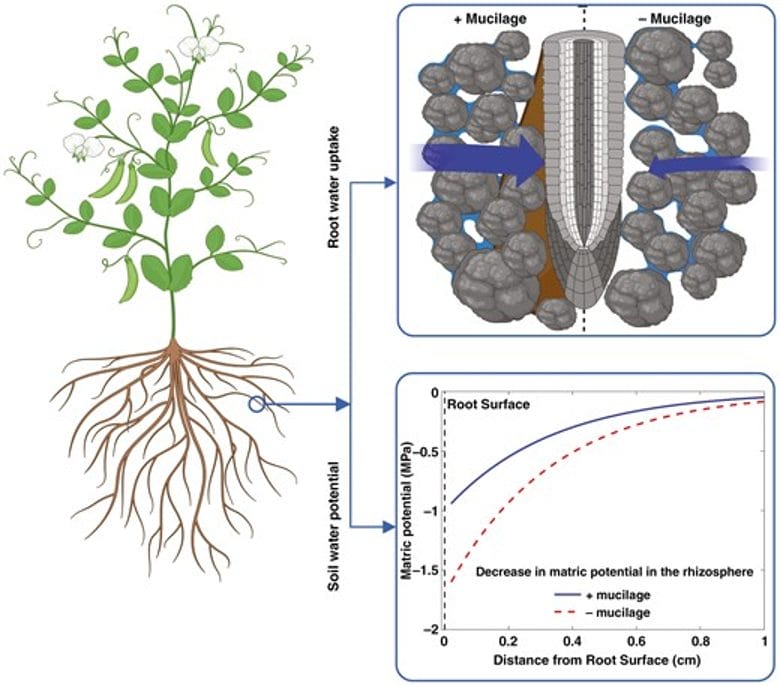May 12, 2025 at 4:13 pm | Updated May 12, 2025 at 4:13 pm | 6 min read
- Root traits are one of the main factors influencing transpiration efficiency or the yield produced per unit of water transpired.
- The root traits to improve transpiration efficiency are rooting depth, root: shoot ratio, density, root hairs, and mucilage.
- No root architecture type suits all species or even all hydrological conditions.
Transpiration efficiency is used to develop cultivars that can future-proof agriculture due to climate change-driven drought and high temperatures. To improve transpiration efficiency, scientists need to adjust the features of the plant that influence the parameter. The root system is crucial to optimizing transpiration efficiency. In this article, you will discover some Key Root Traits to Improve Transpiration Efficiency.
Transpiration Efficiency
Transpiration efficiency (TE) is the plant’s net dry matter per water unit.
Optimal transpiration levels are necessary since the process is essential for absorbing nutrients and water, cooling the plant, and increasing stomatal conductance to boost the photosynthetic rate. However, too much transpiration can result in plant and soil water loss, which must be avoided during water scarcity.
Subscribe to the CID Bio-Science Weekly article series.
By submitting this form, you are consenting to receive marketing emails from: . You can revoke your consent to receive emails at any time by using the SafeUnsubscribe® link, found at the bottom of every email. Emails are serviced by Constant Contact
TE is a parameter to develop cultivars that can future-proof agriculture due to climate change. To improve TE, scientists need to adjust the plant features that influence it. The root system, along with crop ontogeny and carbon allocation, are the crucial internal factors. Meanwhile, soil type, vapor pressure deficit (VPD), and nutrition status are TE’s external factors.
Root System Architecture
The root system architecture, in combination with the soil type, affects the movement of water from soil to plant as it determines the soil volume explored. Soils have varying water-holding and hydraulic capacities that work through the rhizosphere.
The rhizosphere is the thin layer surrounding roots, where root exudates change the soil’s chemistry, physics, and biology, influencing plant growth, nutrition, and defenses.
The combination of varying VPD and soil type can alter root system architecture, which is plastic and responsive to the external environment. The various root architecture traits of length, distribution, density, root hairs, and root-shoot ratio that can change TE are specific to crop species. Scientists want to leverage these features in crop breeding. Landraces have better root traits and water use efficiency than genotypes, which have been improved through crop breeding.
TE is higher in clay soils under high VPD (or dry conditions) than in sandy soils, but the effects are species-dependent. For example, pearl millet has the same TE in sandy and Vertisol soils, but maize TE will vary with soil type.
Root: Shoot Ratio
Plants facing drought suppress shoot growth and prioritize root development to increase their soil exploration capacity for water. As a result, the root: shoot ratio increases. Many scientists have reported this phenomenon. Abscisic acid (ABA), a known root promoter and shoot suppressor, will be found in higher concentrations in rainfed plants to increase soil exploration and maintain yields. For example, a 50% increase in root: shoot ratio as a drought response was seen in wheat.

Figure 1: “Linear regression relationship between the ratio of deep rooting (RDR) with instantaneous water use efficiency (WUEi) (A) and shoot dry weight (B) under drought conditions,” Gobu 2022. (Image credits: https://doi.org/10.3390/plants11091270).
Deeper Roots
Root depth is vital for maintaining and improving yields through drought tolerance, more nitrogen uptake, and a better harvest index. Crops grow deeper roots to explore the subsoil (below 60 cm) for water and nutrition. Some nutrients, like nitrogen, are water-soluble and leach deeper into the soil, carried by water. So, deeper roots access water and nitrogen to improve crop yield. For example, 20% faster root growth to reach deeper levels has increased wheat yields by 0.32–0.44 t/ha.
More root depth can help access moisture from deeper soils, maintain plant turgidity, restrict transpiration to prevent unnecessary water loss from plants and soil, and maintain photosynthesis longer. Deeper roots also increase water use efficiency and yield in some but not all cases (see Figure 1).
Several food crops develop deeper roots in soil drought conditions, for example, rice, wheat, Prunus spp (plums, apricots, cherries, nectarines, almonds, and peaches), and Arabidopsis. A 23.5% increase in root depth is reported in rice.
Root Density
Some crop species increase root density to improve soil exploration, especially in rainfed conditions. With more roots, more water absorption possibilities exist. For example, pearl millet grows dense and profuse roots and can survive high VPD in all soil types.
- Drought-avoiding cultivars have more root density in lower soil layers.
- During the early growing stages, more root density at shallow soil depths is better in rainfed conditions.
However, deep and dense roots are unsuitable for all hydrological conditions, so crop breeding must target specific soil water conditions.
Root Hairs
Root hairs are the contact points of roots to the soil. They increase root radius and absorb surface area, which could help improve water uptake based on species. The extent to which root hairs increase contact with soil determines whether they can increase TE. So, the turnover of root hairs is also crucial.
- Short root hairs in rice and maize do not significantly improve water uptake.
- Long root hairs of barley improve root uptake and influence transpiration.
Root hairs can increase water uptake in drying soils by reducing the matric potential drop at the root and soil interface in high-transpiring plants.
Root Mucilage
As soil dries, the ability to transport water to roots decreases, increasing soil root hydraulic resistance.
Root mucilage is a polysaccharide secreted by the root tip that alters the rhizosphere. Roots with high mucilage maintain hydraulic conductance in the soil, improving water transport from soil to roots and maintaining transpiration, see Figure 2. An optimal level of transpiration is necessary for photosynthesis.

Figure 2: “Without mucilage, the soil matric potential will drop steeply at the root surface, as indicated by the red arrow, which hinders root water uptake (blue arrow). On the other hand, high mucilage concentration at the root surface will maintain the hydraulic conductance between root and soil and attenuate the decline in matric potential at the root surface (red arrow), hence maintaining root water uptake in drying soils (blue arrow),” Abdalla, et a. (2024). (Image credits: https://BioRender.com/s66t170).
Combined Effects
The root traits can be correlated and do not act in isolation. So, several root trait adaptations will co-occur to improve yield and TE in drought conditions.
For example, an intermediate density of crown roots with thicker diameters is better for reducing water use initially and conserving soil water for later crop stages in direct-seeded rice.
Deep-rooting plants can be associated with lower root numbers and dry weight, where density is higher at deep soil layers. Some improved cultivars can use this combination of root traits to reduce root respiration and divert less biomass from shoot growth.
Species and Hydrology Specific Root Systems
No single root architecture type is suitable for all species or even a species in all hydrological conditions. Visa versa, no single root architecture can guarantee an optimal TE for any specific hydrological condition. Moreover, the influence of many factors, such as mucilage, on TE is not fully understood and will require further research. CID Bio-Science provides tools that can be useful in TE research. These are as follows:
- The CI-340 Handheld Photosynthesis System measures transpiration, stomatal conductance, and photosynthesis.
- The CI-600 In-Situ Root Imager and CI-602 Narrow Gauge Root Imager are two root scanners that can be used with minirhizotron systems to measure root morphology and turnover.
These tools can be used in the field and provide accurate results in real time, speeding up research and future-proofing agriculture.
Contact us at CID Bio-Science Inc. for more information on the precision tools for your research needs.
Sources
Cai, G., & Ahmed, M. A. (2022). The role of root hairs in water uptake: recent advances and future perspectives. Journal of experimental botany, 73(11), 3330–3338. https://doi.org/10.1093/jxb/erac114
Carminati, A., Passioura, J. B., Zarebanadkouki, M., Ahmed, M. A., Ryan, P. R., Watt, M., & Delhaize, E. (2017). Root hairs enable high transpiration rates in drying soils. New Phytologist, 216(3), 771-781.
Gobu, R., Dash, G. K., Lal, J. P., Swain, P., Mahender, A., Anandan, A., & Ali, J. (2022). Unlocking the Nexus between Leaf-Level Water Use Efficiency and Root Traits Together with Gas Exchange Measurements in Rice (Oryza sativa L.). Plants, 11(9), 1270. https://doi.org/10.3390/plants11091270
Kulkarni, M., Soolanayakanahally, R., Ogawa, S., Uga, Y., Selvaraj, M. G., & Kagale, S. (2017). Drought response in wheat: key genes and regulatory mechanisms controlling root system architecture and transpiration efficiency. Frontiers in chemistry, 5, 106.
Tron, S., Bodner, G., Laio, F., Ridolfi, L., & Leitner, D. (2015). Can diversity in root architecture explain plant water use efficiency? A modeling study. Ecological modelling, 312, 200-210.
Vadez, V., Choudhary, S., Kholová, J., Hash, C. T., Srivastava, R., Kumar, A. A., … & Anjaiah, M. (2021). Transpiration efficiency: insights from comparisons of C4 cereal species. Journal of Experimental Botany, 72(14), 5221-5234.
Related Products
Most Popular Articles
- Transpiration in Plants: Its Importance and Applications
- Leaf Area – How & Why Measuring Leaf Area…
- How to Analyze Photosynthesis in Plants: Methods and Tools
- Plant Respiration: Its Importance and Applications
- The Forest Canopy: Structure, Roles & Measurement
- Stomatal Conductance: Functions, Measurement, and…
- Forest & Plant Canopy Analysis – Tools…
- Root Respiration: Importance and Applications
- The Importance of Leaf Area Index (LAI) in…
- Irrigating with Saline or Seawater






